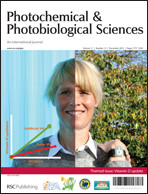The solvatochromic emission properties of five naphthoylurea derivatives with different substitution patterns at the naphthoylurea functionality were investigated, with a particular focus on the influence of inter- and intramolecular H-bonding interactions. The bathochromic shifts of the emission maxima correlate well with the acceptor number or Catalán's acidity of the solvent (Δλ = 47–86 nm), indicating an excited species with a pronounced negative charge that is stabilized by H-bond donating (HBD) solvents. In media with restricted free volume the formation of the charged species is not favored, because the required conformational change to establish an intramolecular charge transfer (ICT) between the fluorophore and the acylurea substituent is hindered, and the emission mainly originates from the locally excited state. This relationship between the alignment of the naphthoyl carbonyl functionality relative to the naphthyl ring and the spectroscopic shift was confirmed by the comparison of the ground state conformation and the emission spectra of the naphthoylurea derivatives in the solid state. Time-resolved experiments revealed different excited entities, whose lifetimes are significantly influenced by the HBD properties and the temperature of the environment. With few exceptions the naphthoylurea derivatives exhibit only two emissive species in the nanosecond range. All experimental data point to conformational relaxation and solvent reorganization leading to the cis and trans isomers of one preferential conformer with respect to the acylurea unit. The structure of the preferred conformation is mainly determined by the possible inter- or intramolecular H-bonds and is therefore also strongly influenced by the HBD and H-bond accepting (HBA) properties of the polar solvents. As the NH groups of the acylurea functionality contribute mainly to the entire inter- and intramolecular H-bond arrangement the variation of the substitution pattern of the urea unit, specifically the presence and position of the NH groups, leads to derivatives with significantly different steady-state and time-resolved emission properties.

You have access to this article
 Please wait while we load your content...
Something went wrong. Try again?
Please wait while we load your content...
Something went wrong. Try again?


 Please wait while we load your content...
Please wait while we load your content...